Thermochemical water splitting uses high temperatures—from concentrated solar power or from the waste heat of nuclear power reactions—and chemical reactions to produce hydrogen and oxygen from water. This is a long-term technology pathway, with potentially low or no greenhouse gas emissions.
How Does It Work?
Thermochemical water splitting processes use high-temperature heat (500°–2,000°C) to drive a series of chemical reactions that produce hydrogen. The chemicals used in the process are reused within each cycle, creating a closed loop that consumes only water and produces hydrogen and oxygen. The necessary high temperatures can be generated in the following ways:
- Concentrating sunlight onto a reactor tower using a field of mirror "heliostats," as illustrated in Figure 1. For more information, see Chapter 5 of the SunShot Vision Study.
- Using waste heat from advanced nuclear reactors. For more information, see the U.S. Department of Energy’s Nuclear Hydrogen R&D Plan.
Numerous solar thermochemical water-splitting cycles have been investigated for hydrogen production, each with different sets of operating conditions, engineering challenges, and hydrogen production opportunities. In fact, more than 300 water-splitting cycles are described in the literature. For more information, see Solar Thermochemical Hydrogen Production Research: Thermochemical Cycle Selection and Investment Priority.
Two examples of thermochemical water splitting cycles, the "direct" two-step cerium oxide thermal cycle and the "hybrid" copper chloride cycle, are illustrated in Figure 2. Typically direct cycles are less complex with fewer steps, but they require higher operating temperatures compared with the more complicated hybrid cycles.
Why Is This Pathway Being Considered?
Solar- and nuclear-driven high-temperature thermochemical water-splitting cycles produce hydrogen with near-zero greenhouse gas emissions using water and either sunlight or nuclear energy.
Research Focuses On Overcoming Challenges
Challenges remain, however, in the research, development, and demonstration of commercially viable thermochemical cycles and reactors:
- The efficiency and durability of reactant materials for thermochemical cycling need to be improved.
- Efficient and robust reactor designs compatible with high temperatures and heat cycling need to be developed.
- For solar thermochemical systems, the cost of the concentrating mirror systems needs to be reduced.
Exciting progress continues in this field, leveraging synergies with concentrated solar power technologies, and with emerging solar-fuel production technologies.



